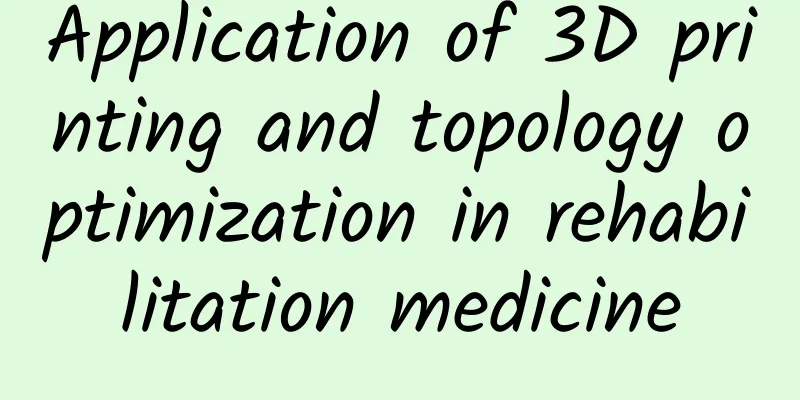Application of 3D printing and topology optimization in rehabilitation medicine

|
Author: Wei Guoqiang, Chief Physician, Changzhi People's Hospital, Shanxi Province Xu Yangyang, Chief Technician, Changzhi People's Hospital, Shanxi Province Wang Yi, Chief Technician, Changzhi People's Hospital, Shanxi Province Reviewer: Wang Pingzhi Chief Physician, Shanxi Bethune Hospital, Director of Rehabilitation Medicine Department, Member of Neurorehabilitation Group, Physical Medicine and Rehabilitation Branch, Chinese Medical Association, Chairman of Physical Medicine and Rehabilitation Professional Committee, Shanxi Medical Association 3D printing, also known as additive manufacturing, is a rapid prototyping technology that uses a variety of adhesive materials (inks) to construct objects layer by layer based on the created digital model files. 3D printing can quickly achieve "what you want is what you get". After the designer uses the computer to perform digital modeling, the input of the 3D printing device can quickly print out the prototype or product, which significantly shortens the design and production cycle. The application of 3D printing in clinical medicine is divided into 3D bioprinting and 3D non-biological printing. The former refers to the printing of biologically active tissues and organs, while the latter is the printing that only realizes appearance and function. The biggest difference between the two is that 3D bioprinting involves cell participation, which can achieve more advanced life activities that are even close to normal human tissues and organs, and is the ultimate pursuit of 3D printing in the field of clinical medicine. At present, due to the limitations of technology and raw materials, most domestic rehabilitation medicine departments use 3D non-biological printing, but each work is unique, with accurate data, precise mechanical measurements, personalized design, brand-new appearance and good matching. With the development of science and technology, the application scope of 3D printing will become wider and wider. Topology optimization (TO), as a computer-aided design method, is often used to design and manufacture various novel and complex structures with advantages such as adjustable stiffness, layered features and excellent lightweight performance. Figure 1 Copyright image, no permission to reprint Coincidentally, the tissue development of many organ structures in the human body has also gone through the process of additive manufacturing and topological optimization. For example, bones are continuously deposited in key load-bearing areas, while gradually becoming sparse in non-load-bearing areas. Through repeated topological optimization, the bone structure is finally optimized and distributed in important load-bearing areas, achieving a perfect balance between strength and weight. Although the application of 3D printing technology in rehabilitation medicine is limited by proprietary materials, topological optimization can make up for this deficiency to a certain extent. The combination of 3D printing and topological optimization can effectively solve many problems in rehabilitation medicine. In recent years, we have actively explored the application of 3D printing and topology optimization technology in rehabilitation medicine, mainly involving the following aspects: 1.3D Medical Model It can be used for clinical teaching and surgical simulation, and can be restored, enlarged or reduced as needed. It has the characteristics of being objective, real, intuitive, touchable and able to be simulated. Figure 2 Copyright image, no permission to reprint 2. Orthopedic treatment (1) Cervical fixation orthosis: It is personalized according to the injury and surgical conditions, easy to wear and quick to wear. The stability, comfort and range of motion can be adjusted at any time according to the course of the disease and the patient's needs. Topological optimization achieves lightweight and facilitates observation of the injury. Production process: Figure 3 Copyright image, no permission to reprint Wear Figure 4 Copyright image, no permission to reprint Figure 5 Copyright image, no permission to reprint (2) Toe orthosis: Collect foot images, perform biomechanical design after modeling, and customize orthotics to accurately correct toe deformities. Figure 6 Copyrighted images are not authorized for reproduction (3) Lightweight fingerboard: The fingerboard is improved and adjusted to the shape to reduce weight and improve breathability. Figure 7 Copyright image is not authorized for reproduction (4) Finger joint orthosis: used for interphalangeal joint and metacarpophalangeal joint deformities caused by rheumatoid arthritis, trauma, etc. It has a personalized design and can be adjusted in time. Figure 8 Copyright image, no permission to reprint (5) Thumb and index finger stretch orthosis: It is used to stretch and correct hand contractures caused by stroke, nerve damage, etc. It is digitally designed and is beautiful, breathable, and comfortable. Figure 9 Copyright image, no permission to reprint (6) Ankle-foot fixation orthosis: It can replace plaster and can be pre-installed with padding such as clothes and socks. It is easy to remove, breathable, lightweight after topological optimization, and easy to observe the injury. Figure 10 Copyright image, no permission to reprint (7) Elbow joint fixation orthosis: It replaces traditional plaster and can be pre-installed with clothing padding. It is easy to remove, breathable, lightweight after topological optimization, and easy to observe the injury. Figure 11 Copyright image, no permission to reprint (8) Thoracolumbar fixation orthosis: lightweight after topological optimization, making it easier to observe the injury. Figure 12 Copyright image, no permission to reprint (9) T-shoe orthosis: It can be used to treat internal and external rotation deformities of the lower limbs in patients with stroke, lower limb fractures, etc. The heel device can be used to adjust the angle. Figure 13 Copyright image, no permission to reprint (10) Orthopedic insoles: personalized design, topologically optimized, can adjust the height and stiffness of the arch, sole and toes at any time to achieve orthopedic treatment. Figure 14 Copyright image, no permission to reprint 3. Improved tools Design and improve tools and equipment suitable for patients and therapists. Figure 15 Copyright image, no permission to reprint 3D printing technology has the following advantages: personalization, good fit, high precision, short manufacturing cycle, light structure, good breathability, good waterproof design, preset padding, fast iteration and update, good permeability (easy to observe), and can be adjusted at any time according to patient response or changes in condition. At the same time, there are also the following shortcomings: first of all, the material is lacking in printing materials that take into account comfort, firmness, and durability. Although topological optimization can make up for the lack of certain rigidity and elasticity, the poor comfort is still not conducive to long-term wear; in addition, there are also problems such as difficulty and high cost in post-professional processing (smoothness, process). With the advancement of materials science and the integration of new technologies, technologies such as 3D printing and topological optimization will bring about rapid changes in rehabilitation medicine. |
>>: Don't be careless if your voice is hoarse, beware of laryngeal cancer
Recommend
What is the nutritional value of winter melon seeds? What is the medicinal value of winter melon seeds?
Winter melon seeds are the seeds of winter melon....
Moderate cervicitis
For female friends, cervicitis is a very scary di...
How to check fetal hearing during pregnancy
The development of the fetus is an issue that man...
What kind of leucorrhea is normal?
If a woman's secretions are abnormal, it is v...
What kind of care liquid should be used for female private parts
Nowadays, we see various kinds of female private ...
Can a woman with intrauterine adhesions keep the baby?
Intrauterine adhesions can have many adverse effe...
How to relieve flatulence and indigestion? What should we pay attention to in diet?
Nowadays, with the accelerated pace of life and i...
What is the reason for irregular menstruation after childbirth?
There are many reasons that lead to irregular men...
Can I eat pears during menstruation?
The menstrual period is a sensitive period for fe...
Is cesarean section pregnancy safe?
In recent years, many young women have chosen ces...
So?! It is not recommended to wear headphones when riding the subway???
Don’t be fooled by the small size of earphones. I...
Why is there still blood after my period?
Many women know that ovulation bleeding during th...
Early pregnancy symptoms nipple pain
For pregnant women, it is a very joyful and magic...
What should I pay attention to when I am pregnant 5 months after cesarean section?
Nowadays, cesarean section has become the method ...
Prevent cerebral infarction and protect brain health!
1. Introduction Cerebral infarction, also known a...









